“About Trout” is a series of articles written by members of Forbes Trail Trout Unlimited and published in the Latrobe Bulletin.
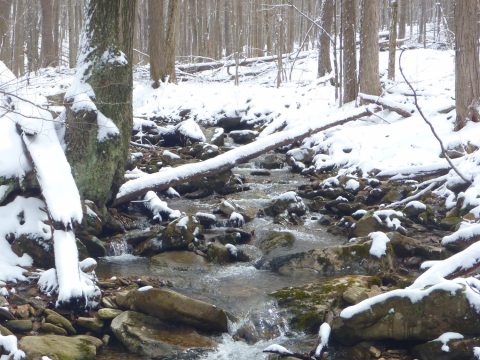
Christmas and Trout
Apart from all the excitement of a busy holiday season, Rick Yaksic reminds us that some of our best gifts can be found in quiet flowing waters of winter forests, awaiting the promise of spring.
There’s something about Christmas that feels like water – the kind that moves slowly under ice, whispering, carrying stories along its current. Maybe that’s why trout come to mind every December. Both have a quiet magic, a sense of peace and patience that’s earned, not given. Christmas and trout share that rare blend of stillness and wonder, a reminder that the best gifts are often caught, not wrapped.
Winter on the water looks nothing like summer’s bright rush. The trees are bare, the banks stiff with frost, and the surface sometimes glints with the skin of ice so thin it seems afraid to be real. Yet beneath it, the river still breathes — slower now, deeper, wiser. Trout move differently in this season, hugging the bottom, conserving their strength. They wait for the right drift, the right light, the right moment.
So do we.
Christmas has a similar rhythm if you let it. Beneath all the noise and neon, there’s a deep current of reflection. It asks us to slow down, to find still water. To remember who’s gathered by the fire and why that matters more than any package under the tree. The river, much like the holiday, is an invitation to pay attention — to listen, to be quiet, to notice the flicker of life beneath the surface.
Anyone who’s tried to catch trout in December knows it’s not about numbers. The fish are cautious, the air is sharp, and the water cuts like glass. You learn to read the river differently. You tie smaller flies, use lighter tippet, and cast with care — because even a single strike feels like grace. And that’s the beauty of it. The winter angler learns humility. You can’t bully the river when it’s cold. You can’t rush the process. You must accept the conditions as they are — not as you wish them to be. It’s a lesson that applies just as well to family gatherings and Christmas mornings. Trout fishing teaches you to find joy in what’s present: the steam from your breath, the crunch of snow under boots, the single rise of a fish beneath gray skies. It’s a kind of mindfulness disguised as sport. The river reminds you that life, like trout, often takes the fly when you least expect it — and only if you’ve been patient enough to drift it naturally. Christmas often carries two stories: one of joy and togetherness, another of solitude. Not everyone spends it surrounded by laughter and light. For some, it’s a time of quiet remembrance — of those who are gone, or far away, or simply missed. The river understands this language of absence. Standing in waders on a winter stream, you can feel the world narrow to a few simple truths: the pull of the current, the bend of your rod, the heartbeat of the moment. There’s comfort in that solitude. You’re never entirely alone when you can hear water moving — it’s the same sound that’s been singing through time, through every December before and after you. Fishing on Christmas morning, or even just walking along the bank, becomes a kind of prayer. Not the loud, performative kind, but a small, steady gratitude. You thank the year for what it gave, forgive it for what it didn’t, and let the river carry the rest downstream.
Still, the best stories — whether of Christmas or of trout — tend to circle back to company. The warmth of friends after a cold morning on the water. The way coffee tastes better from a thermos when your fingers are half-frozen. The laughter that erupts when someone’s “big catch” turns out to be a soggy branch or a spectacular tangle of line. Fishing and Christmas share a deep respect for tradition. You pass them down, not through instruction manuals, but through moments. Maybe your father showed you how to mend a line, or your grandmother always made cocoa after the first snowfall. Maybe someone you love told you that patience is just another word for faith. These rituals don’t need rewriting; they need repeating. There’s a certain poetry in returning to the same stream year after year — the same as returning to a family table. The faces may change, the flows may shift, but the heart of it remains: connection. You realize that the real catch isn’t the trout, but the time spent waiting for it together. Trout are masters of subtlety. Their world is built on reflections and ripples, on light bent through moving water. They thrive in what’s overlooked. Christmas, too, rewards the eyes that see beyond the obvious. It’s not in the glitter or the perfect wrapping, but in the small gestures — a hand-written note, a call to an old friend, a shared silence by the fire. The river teaches the same: that beauty often hides in motion, in imperfection, in things you can’t quite hold. Maybe that’s why fly fishers are such reflective souls. You can’t spend time tracing currents and not start to see yourself in them. The river mirrors back your patience, your stubbornness, your hope. Christmas does too. It holds a mirror up to who we’ve been all year and asks quietly, what have you learned about love?
If there’s one thing every angler knows, it’s that the best fish live forever in memory. The one that broke the line. The one that rose once and disappeared. The one that made your heart race even though it never came to hand. Christmas is built on the same kind of faith — belief in what we can’t quite grasp, but know is real. We cast into the dark, trusting that something unseen might rise. And sometimes, when the timing’s right and the heart’s open, it does. That’s the real connection between Christmas and trout: both ask you to show up with hope. To believe in unseen things. To keep casting — not because you’re guaranteed a bite, but because the act itself is worth it.
In the end, trout and Christmas share a single truth: both are about returning. To water, to warmth, and wonder, to what’s essential. The season reminds us that peace isn’t found in abundance, but in awareness — the same way trout finds safety not by swimming harder, but by settling into the right current. So, whether you spend your Christmas morning under twinkling lights or under a low gray sky with a fly rod in hand, remember: the river is still running, the world is still generous, and the best gifts are already here — moving quietly beneath the surface, waiting to be seen.
This article was written by Rick Yaksic, Forbes Trail Trout Unlimited’s chapter president.
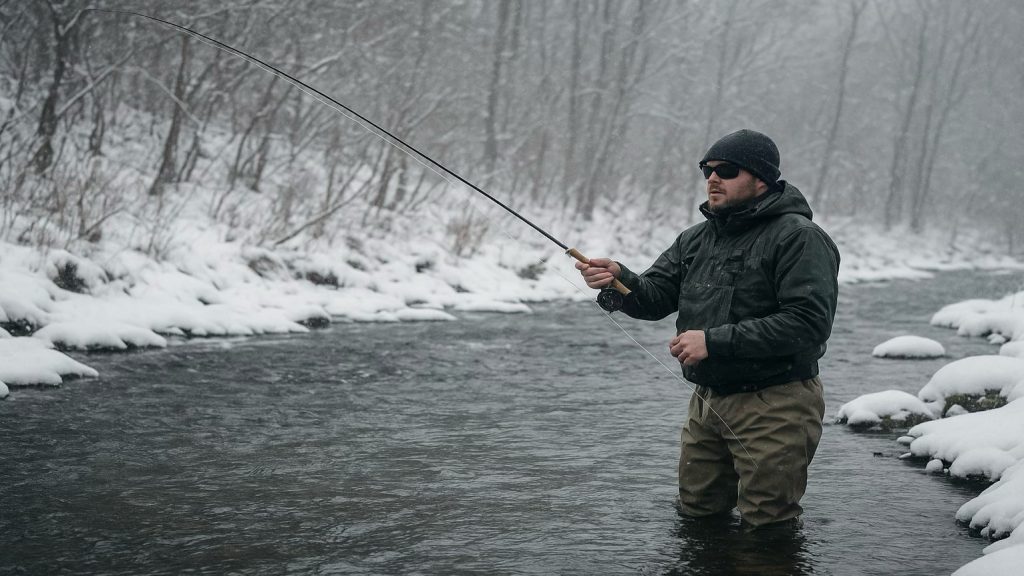
Winter Waters: The Off-Season Secrets of Dedicated Fly Fishers
Don’t hibernate this winter, enjoy the quiet and solitude offered by winter trout fishing.
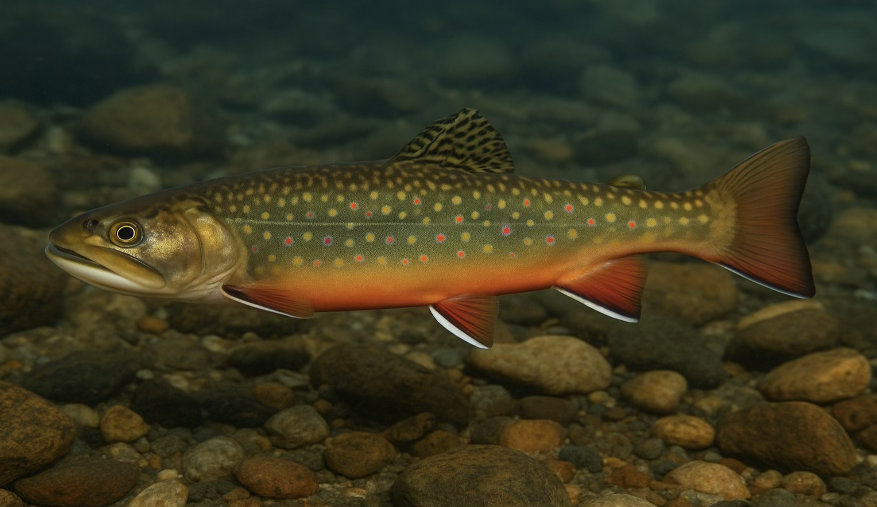
Whispers of the Stream
The Journey of the Native Brook Trout
by Rick Yaksic / Forbes Trail TU
When most anglers in Western Pennsylvania hang up their rods and waders in late fall, a few stubborn souls are just starting to get serious. To them, winter isn’t the off-season, it’s the secret season. While casual fishermen are inside sipping coffee and watching snow fall from the window, these hardy fly fishers are pulling on insulated waders and heading toward the region’s icy creeks and rivers.
From the winding waters of Loyalhanna Creek to the deep runs of the Youghiogheny and the shaded banks of Laurel Hill, Western Pennsylvania’s streams hold more than just trout in the winter. They hold solitude. The constant hum of summer traffic is gone, the shorelines are quiet, and even the birds seem to whisper.
“It’s peaceful in a way that’s hard to describe,” says Monty Murty, a veteran member of Forbes Trail Trout Unlimited. “You hear the water more clearly, you see the steam rising off it, and sometimes you’ll go a whole day without seeing another person. For me, that’s paradise.”
But paradise comes with frostbite risks and frozen rod guides. Winter fishing in Pennsylvania isn’t for the faint of heart. Preparation, patience, and a touch of stubbornness are required to make it through a day on the water. The dedicated few who venture out are rewarded with trout that are just as beautiful—and sometimes even more cooperative—than those of summer.
Reading the Winter Water
In cold weather, trout seek the path of least resistance. “They’ll sit deep and slow, conserving energy,” explains Larry Myers, another longtime fly fisher. “That means you have to slow down your presentation and put your fly right in front of their nose.”
On most days, that means fishing deeper pools and tailouts—places where the current softens and trout can hold without expending much effort. Anglers often turn to nymphing, bouncing small flies like midges, pheasant tails, or stonefly imitations close to the bottom. Egg patterns also work well during the colder months, especially below spawning areas.
“It’s not about flashy casts or big dry flies this time of year,” Myers continues. “It’s about precision and patience. You might only get a few good drifts before your fingers go numb, but when that indicator twitches, it’s worth every frozen toe.”
Dressing for the Chill
Ask any winter angler, and they’ll tell you the same thing—comfort keeps you casting. Layers are essential, starting with moisture-wicking base layers, followed by insulation, and topped with waterproof outerwear. Breathable waders paired with thick socks and insulated boots keep the lower half warm, while fingerless gloves allow enough dexterity to tie knots without freezing solid.
Some anglers even carry small chemical hand warmers or a thermos of hot coffee to stave off the chill. “I’ve fished days when the guides on my rod froze every few casts,” says one local fly fisher from Ligonier. “You learn to deal with it. That’s part of the fun—telling yourself you’re a little tougher than the cold.”
The Beauty of Solitude
While the physical challenges of winter fly fishing are real, the mental rewards often outweigh them. Snow-dusted banks, low golden sunlight, and the soft gurgle of the current create a sense of stillness that summer simply can’t match.
“Winter fishing feels almost sacred,” says Monty. “You’re standing in the same waters you fished all summer, but they feel different—quieter, slower, more intimate. It’s like the world finally took a deep breath and exhaled.”
And that solitude isn’t just for the spirit—it benefits the fishing, too. With fewer anglers on the water, trout experience less pressure and can be more willing to bite. Many local fly fishers keep their winter spots close to the vest, sharing only vague hints about where the fish are holding.
“You’ll hear things like ‘somewhere near Donegal’ or ‘not far from the Turnpike,’” jokes Myers. “Nobody gives away their winter holes. You earn them by freezing for them.”
The Gear Adjustments
Beyond warm clothes, winter conditions demand small tweaks to the tackle. Thinner tippets help achieve delicate presentations, and weighted nymph rigs or split shot keep flies near the bottom. Some anglers even swap slightly shorter leaders to make managing line easier when fingers are stiff.
Drift control becomes crucial as icy winds and sluggish currents play tricks on even the most experienced casters. Fluorocarbon tippet, known for its near invisibility and quick sink rate, has become a winter staple.
And while fly patterns simplify—mostly midges, eggs, and small mayflies—color and size still matter. On bright days, subtle shades of gray or cream tend to work best, while overcast skies call for slightly darker tones.
Why They Do It
Ask ten winter fly fishers why they’re out there when the thermometer reads 28 degrees, and you’ll get ten different answers—but all will circle back to passion. Some do it for the quiet. Some do it for the challenge. Others do it because fishing is less about catching and more about being connected—to the water, to nature, and to themselves.
“It’s not about filling a creel,” says Monty. “It’s about filling your soul. When you’re knee-deep in an icy stream and a rainbow trout flashes silver in the current, that’s pure joy. You forget about the cold. You forget about everything.”
As snow drifts along the Laurel Highlands and frost coats the rhododendron leaves along the streambanks, these dedicated anglers keep casting, chasing something only they can fully understand.
Winter may be the off-season for most, but in Western Pennsylvania, it’s when the truest fly fishers come alive.
“If you can handle a Western Pennsylvania winter on the water,” one old-timer says with a grin, “you’ve earned every trout you catch.”
By Forbes Trail Trout Unlimited
Long before highways stitched the land and coal trains wound through the valleys, the mountains of the East whispered with the sound of clean, tumbling water. Hidden among these ancient ridges—where the roots of Eastern hemlocks gripped the earth and fog hung low over laurel thickets—lived a small, brilliantly colored fish that belonged entirely to this place: the native brook trout. Known to science as Salvelinus fontinalis, the brook trout is not technically a trout at all but a member of the char family, a cousin to Arctic grayling and lake trout. But to those who have spent time in the shadows of the Appalachians, Alleghenies, and Adirondacks, the brookie is more than a species. It is a symbol of purity, resilience, and the soul of cold water itself.
An Ancient Resident
The brook trout has called the waters of eastern North America home since the end of the last Ice Age. As glaciers retreated, meltwater carved out new streams, and brook trout followed—taking up residence in clear, oxygen-rich headwaters where temperatures rarely rose above 65 degrees Fahrenheit. They became perfectly adapted to these environments, with small bodies, quick reflexes, and brilliant camouflage. Their speckled backs mimicked the gravel streambeds; their red fins tipped in white flashed like leaves caught in a current. For thousands of years, brook trout thrived in these clean mountain waters. Indigenous peoples, such as the Lenape, Shawnee, and Iroquois, caught them with woven traps and spears. To them, the brook trout was a gift—part of a deeply interconnected world of water, land, and spirit. Their presence in a stream meant the water was still good, the forest still strong.
A Turning Tide
Then came settlers, sawmills, iron furnaces, and railroads. In the 1800s and early 1900s, the Eastern forests were stripped bare for timber, charcoal, and farmland. Without shade, stream temperatures soared. Erosion dumped silt into spawning beds. Acid from coal mines turned waters orange and toxic. Where there were once narrow channels filled with dancing brookies, there were now ditches, warm and lifeless. At the same time, non-native fish were introduced—often with the best of intentions. Rainbow trout from the West and brown trout from Europe were stocked by the thousands to provide sport for anglers. These invaders were hardy, grew larger, and often outcompeted native brook trout for food and space. Some even hybridized with them, further threatening their genetic purity. By the middle of the 20th century, brook trout had disappeared from much of their historic range. In places like Pennsylvania, New York, Virginia, and North Carolina, they clung to survival in the highest, coldest, most remote streams—refugia at the roof of the world.
The Beginning of a Comeback
The decline did not go unnoticed. In the 1960s and ’70s, a wave of environmental awareness swept across the country. The Clean Water Act passed. Conservationists, biologists, and concerned anglers began to look upstream—literally—to see what had been lost. And in those hidden mountain hollows, they found survivors. The brook trout, it turned out, had not given up. Organizations like Trout Unlimited, state fish and wildlife agencies, and watershed associations began to act. They surveyed remote streams, sampled water quality, and mapped genetic lineages. In time, entire restoration plans took shape. The work was long and often unglamorous: removing abandoned culverts, planting streamside trees, building in-stream structures to cool the water and create habitat. Volunteers hauled buckets, wielded shovels, and hiked miles just to count fingerlings. In schools, children raised trout eggs in classroom tanks—watching them grow from specks into finger-length fry before releasing them into the wild. For many of these students, it was their first connection to wild nature. For the brook trout, it was another step home.
A Living Indicator
More than just a beautiful fish, the brook trout has become a symbol of ecological integrity. Because they are so sensitive to temperature, sediment, and pollution, their presence—or absence—tells a story about the health of the landscape. Where brook trout live, forests are strong. Groundwater flows cleanly. Waters run cool. Their survival is not just a conservation goal—it’s a barometer for the entire ecosystem.
Today and Tomorrow
Today, thanks to decades of effort, wild brook trout populations have stabilized in many areas, and even rebounded in some. In parts of Pennsylvania, Virginia, and the Northeast, native brook trout are once again rising to dry flies cast by careful hands. In other regions, wild fish are returning to streams where they haven’t been seen in generations. Still, threats remain. Climate change looms large, warming streams and reducing cold water habitat. Development continues to fragment watersheds. Invasive species persist. But there is hope!
Hope in the volunteers who spend their weekends measuring pH levels. In landowners who protect headwaters on their property. In youth programs that teach casting and conservation together. And in the quiet, persistent heartbeat of a fish that has endured so much—and still glows like fire in a forest stream.
The brook trout teaches us that restoration is possible, but it is not quick. It flows like a stream: steady, patient, and winding. And if we listen closely, we can still hear the whispers of the water, telling us to protect what is wild—and to never take clean, cold streams for granted.
The Local Heroes: Forbes Trail Trout Unlimited
Among the many organizations fighting for the future of native brook trout, one small but mighty chapter stands out in the Laurel Highlands of Pennsylvania: Forbes Trail Trout Unlimited.
Formed by a group of passionate anglers and conservationists, Forbes Trail TU has become a power force for coldwater conservation in Westmoreland and surrounding counties. Their mission is clear-protect, reconnect, restore, and sustain the region’s coldwater fisheries, especially those still home to wild brook trout. Over the years, Forbes Trail TU has tackled critical restoration projects across several watersheds (primary focus is Linn Run). Working together with local partners, landowners, and government agencies, they’ve helped stabilize stream banks, improve water quality and reduce erosion. They’ve also focused on removing barriers to fish movement. Old, crumbling culverts that once blocked trout from upstream spawning grounds. Forbes Trail has helped restore the natural rhythm of the water. Our members wade into streams with nets and thermometers, collecting water quality data that helps guide restoration work and monitor the health of fragile brook trout populations.
But their work doesn’t end in the field. Forbes Trail Trout Unlimited is deeply committed to education. Through youth fly fishing programs, classroom trout rearing projects (Trout in the Classroom) and public workshops, we are inspiring a new generation of conservationists. Our volunteers regularly visit schools to talk about aquatic insects, stream ecology, and the magic of brook trout- sparking curiosity and care in young hearts.
Most importantly, we lead by example. Forbes Trail TU understands that protecting brook trout is not just about fish- it’s about people, communities, and the shared responsibility to safeguard what remains wild and beautiful. Our dedication has made us a cornerstone in western Pennsylvania- a reminder that even a small group of passionate volunteers can make a lasting impact on the land, water, and the living things within it.
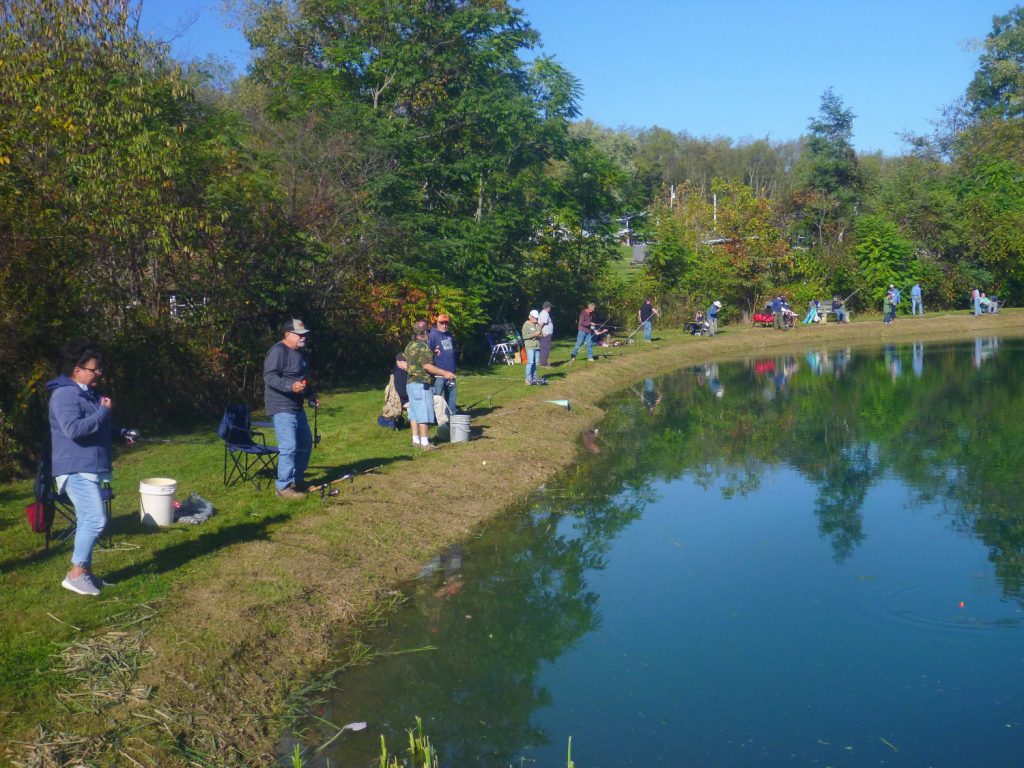
Fly Fishing to Heal the Body and Soul
FTTU has been organizing a special fishing day for Military Veterans and First Responders since 2018. The 2025 event is coming up on October 4th.
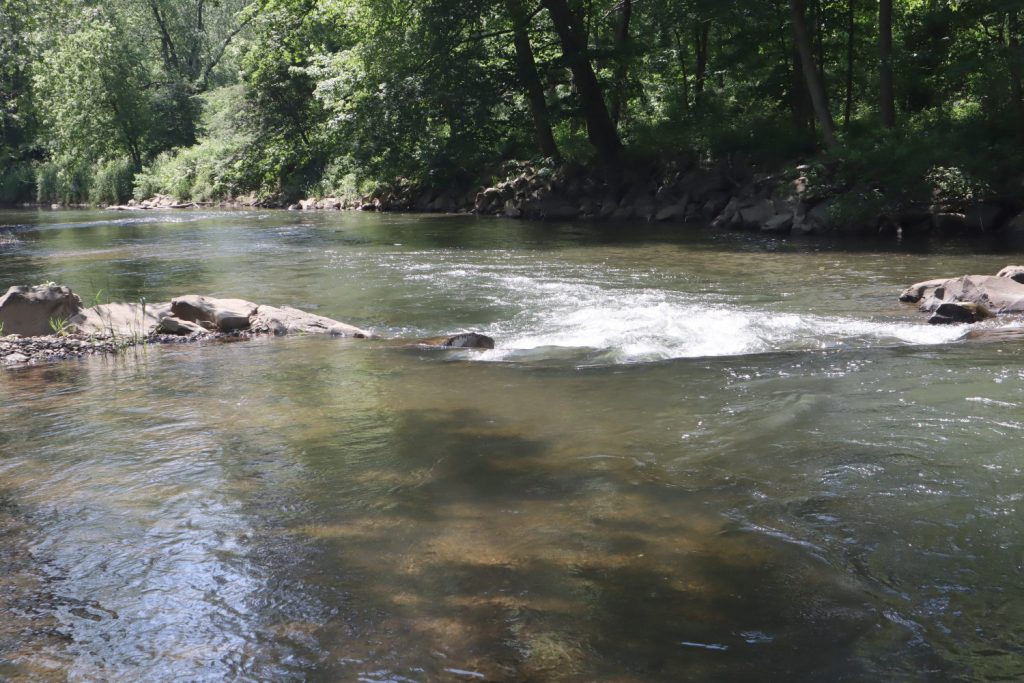
The "Holy Water"
Here in Westmoreland County, we have our own “Holy Water” – Loyalhanna Creek and its tributaries.
Photo: Anglers line the banks of the Kingston Club Lake on a beautiful fall day in 2024.
Trout Unlimited (TU) is a national, nonprofit organization whose mission is to conserve, protect and restore our coldwater fisheries and their watersheds. TU’s work includes stream remediation, constructing riparian buffers, developing trout habitat and protecting wild, naturally reproducing trout. We are currently doing a restoration and recovery project on two tributaries of Linn Run.
We also conduct programs in local schools, including Trout in the Classroom, as well as education and outreach events in our local communities. We are currently working with Greensburg, Hempfield, Latrobe and Ligonier Valley School Districts. We teach coldwater conservation lesson plans, stream etiquette, macroinvertebrates, fly tying and casting. And with some classes, we take them out on the stream to fish or to study stream ecology and chemistry. This is an opportunity for TU to recruit and groom our next generation of conservationists. These types of activities keep our volunteers busy on a weekly basis from December until late May.
But that’s not all we do. National TU introduced the program of fly fishing to military veterans many years ago to bring the therapeutic healing of fly fishing to our nation’s heroes. First responders were added a few years back and the program is now called the TU Service Partnership honoring those who have served their country and communities. Many of TU’s 400 local chapters nationwide, have started programs like this.
Forbes Trail’s program continues to grow each year. Part of the reason for this article is to encourage more of our readers, and their friends throughout Westmoreland County, to take advantage of this activity. Veterans and first responders are welcome to bring an adult friend with them to the events. Our next event will be Saturday, October 4, 2025. It will once again be held at Kingston’s Lake from 9 AM until 3 PM. Their manicured club grounds provide ADA access to their lake, pavilion and restroom facilities. The setting is perfect for everyone!
The entire event is free. We provide lunch, drinks, snacks, fishing equipment and mentors for those who need assistance. As previously noted, the program initially was intended to introduce military veterans to fly fishing as a means of R&R to address issues such as PTSD. It also provides a new means of recreation for veterans with physical disabilities. TU’s mentors work one-on-one with beginners to teach them to cast, present the fly so it looks natural, and land a fish with a net. Fly fishing itself, with the rhythm of the cast, is relaxing. Add to that the sounds and beauty surrounding a cold mountain stream, and it’s hard not to forget about all the physical and emotional pains, if for just one day.
Recently we expanded the program so even those veterans who are experienced anglers can enjoy a relaxing day on the water. And we have extended the invitation to include first responders. They too deal with stress, anxiety and losses in their jobs of serving our communities. They too need some R&R. The event is an opportunity for TU volunteers to serve those who have served their country and communities, and in many cases, continue to do so.
Our primary partner in the events has recently been Kingston Veterans Sportsmen Association who provides the facilities at no charge and stocks the lake with trout, bass and catfish. The other partner is Scout Troops 465 and 305. They start the event posting colors then invite veterans to participate in retiring worn American flags. The U. S. flag code requires “The Flag, when it is in such condition that it is no longer a fitting emblem for display, should be destroyed in a dignified way, preferably by burning.” The Scouts and veterans join in a solemn and dignified ceremony complete with patriotic music in the background. Many of our veterans have said it’s the posting of colors and retiring the flags by the Scouts that they enjoy the most. They enjoy seeing the next generation in their Scout uniforms. It’s a good learning experience for the Scouts as well. The other service the Scouts provide is a grilled lunch for all the veterans, first responders and volunteers.
Many of our participants date back to our first event in 2018. Everyone who has attended has been extremely appreciative and vows to return the following year. We find it easier to recruit new veterans and first responders knowing they can bring a friend. They sit along the lake playing the “do you remember when” game. And sometimes the fishing, and fish stories, become a little competitive. They quickly learn to extend their arms holding a fish for the photographer to make it appear slightly larger than it really is. All part of the fun!
In addition to our terrific partners, we have been fortunate to have several event-sponsors each year including Fish USA, Home Depot, four local Giant Eagle Supermarkets, Westmoreland Case Management and Bubba’s Kitchen and Bar. With their support, we can offer this event at no cost. And we are always looking for additional sponsors.
If you are a military veteran or actively serving, or are an active or retired first responder, please consider joining us in 2025. We ask you to share this story with friends and family. We still have room around the lake to accommodate more anglers. We will do everything in our power to “get you hooked” and show you a fun day.
Photo: Riffles, Runs and placid pools characterize Loyalhanna Creek just a stones throw from downtown Ligonier.
“Don’t let it be said, and said to your shame, that all was beauty here, until you came”. Trout Unlimited founders had that sign placed along northern Michigan’s polluted Au Sable River in 1959. They were making a public statement of what they stood for. The big idea was that if we “take care of Mother Nature’s trout streams, then Mother Nature will take care of our trout fishing.” They were building a strong community of passionate trout anglers who wanted to conserve the natural resources they valued so much. Within a decade TU’s brand of trout stream conservation and restoration had proven itself as the Au Sable River became one of the best trout fisheries east of the Rocky Mountains. TU regards the Au Sable River as the “Holy Water”.
Ligonier trout anglers had a reason to start their own TU chapter after Hurricane Agnes flooded the Ligonier Valley with nearly 15 inches of rain in a 24-hour period in 1972. It devastated trout fishing in the Loyalhanna Creek watershed. So, they formed the Forbes Trail Chapter of Trout Unlimited in 1973, and within a decade they had achieved a major success restoring the Loyalhanna Creek as a trout fishery. Now, the stream section between the US Route 711 Bridge, and the Twomile Run Bridge in Ligonier is a beautiful public trout stream, designated Keystone Select Trout Waters by the PA Fish & Boat Commission. It provides anglers with an exciting opportunity to fish for larger trout measuring between 14 to 20 inches. Trout are stocked there under the Delayed Harvest Artificial Lures Only special regulations that permit year-round fishing. It is listed on the Laurel Highlands Trout Trail (www.laurelhighlandstrouttrail.org) as one of the Laurel Highlands’s top ten trout streams. Forbes Trail TU regards the Upper Loyalhanna Creek as its “Holy Water”.
The Loyalhanna Creek flows from its headwaters near Donegal to Saltsburg where it joins the Conemaugh River to form the Kiskiminetas River. The stretch from Kingston Dam upstream to the headwaters is classified by the state as a coldwater fishery. From Kingston Dam upstream to the area known as Longbridge, the Loyalhanna passes through the Chestnut Ridge. This area is known as the Loyalhanna Gorge. It is open to the public, and has many pull-offs with access to the stream. US Rt. 30 is a divided highway through the gorge, and may be crossed at its midpoint by a causeway in the area known as Sleepy Hollow. It is a stocked fishery.
Between the Loyalhanna gorge and the Keystone Select area in Ligonier the stream widens and becomes shallow, and therefore warmer. The Four Mile Run tributary joins the Loyalhanna Creek behind Idlewhild Park. It is a trout stocked fishery best fished early in trout season when the water is higher and colder. But this section is blessed with several small, cold, clear high-gradient tributaries, St Clair Run and Coal Pit Run, that hold populations of wild trout.
Mill Creek, Ligonier Township, joins the Loyalhanna within the Keystone Select section. It is classified a High Quality Coldwater Fishery by the state. It is the Loyalhanna Creek’s largest high quality trout stream by water volume. During the 2000’s Forbes Trail Chapter conducted both the outdoor scientific studies, and the indoor work of public hearings to secure the grassroots and landowner support for the first definitive coldwater conservation plan within the Loyalhanna Watershed. The decade-long habitat restoration project included more than 100 stream structures along 5 miles of trout streams open to the public.
Our chapter is looking forward to opportunities improving trout habitat above the Keystone Select section, particularly the former Ligonier Beach property, now owned by Ligonier Township, and about to become open to the public. Its landscape will be redesigned for recreational use, and could perhaps include a highly accessible trout fishing area for anglers with mobility challenges.
The smaller tributaries of the Upper Loyalhanna Creek, particularly Linn Run in the Linn Run State Park, are the Exceptional Value and Class A Wild Trout fishery gems of the entire watershed. Forbes Trail Chapter has recently completed a Coldwater Conservation Plan for Linn Run, and we have begun conservation projects to address findings of special concern. We were excited to find that the Linn Run watershed holds a Natural Heritage Area of ‘Global Significance’, the highest rating in the Federal Natural Heritage Program, and contains unique, rare stoneflies (trout bugs) heretofore unknown. However, Linn Run trout waters range from outstanding to poor, and in need of conservation action. And Linn Run stream bank habitat, while beautiful, are under stress from invasive species like Hemlock Wooly Adelgid that are killing the native Eastern Hemlock, so necessary to keep the stream cool in our warming climate.
Our Trout Unlimited national organization, 300 chapters in 30 states, with more than 300,000 members and supporters, is undertaking a new strategy, called Priority Waters, to identify America’s best trout and salmon waters, and to give them TU’s kind of love, and coldwater conservation. Forbes Trail’s coldwater conservation plans have secured for our Laurel Highlands, inclusion among Trout Unlimited’s Priority Waters. Our chapter goal continues to be caring for and recovering Westmoreland County’s coldwater streams so our children can experience the legacy and joy of fishing for trout in our “Holy Water”.
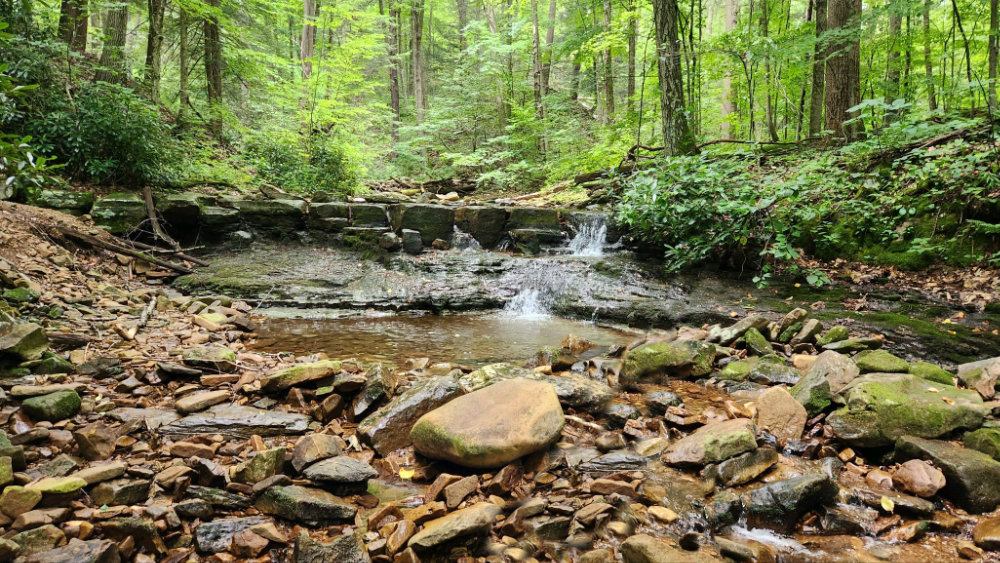
Fishing Ethics During Low Water Conditions
Unfortunately, we seem to be experiencing drought and high temperature conditions one summer after another. To fish or not to fish? That is the question.
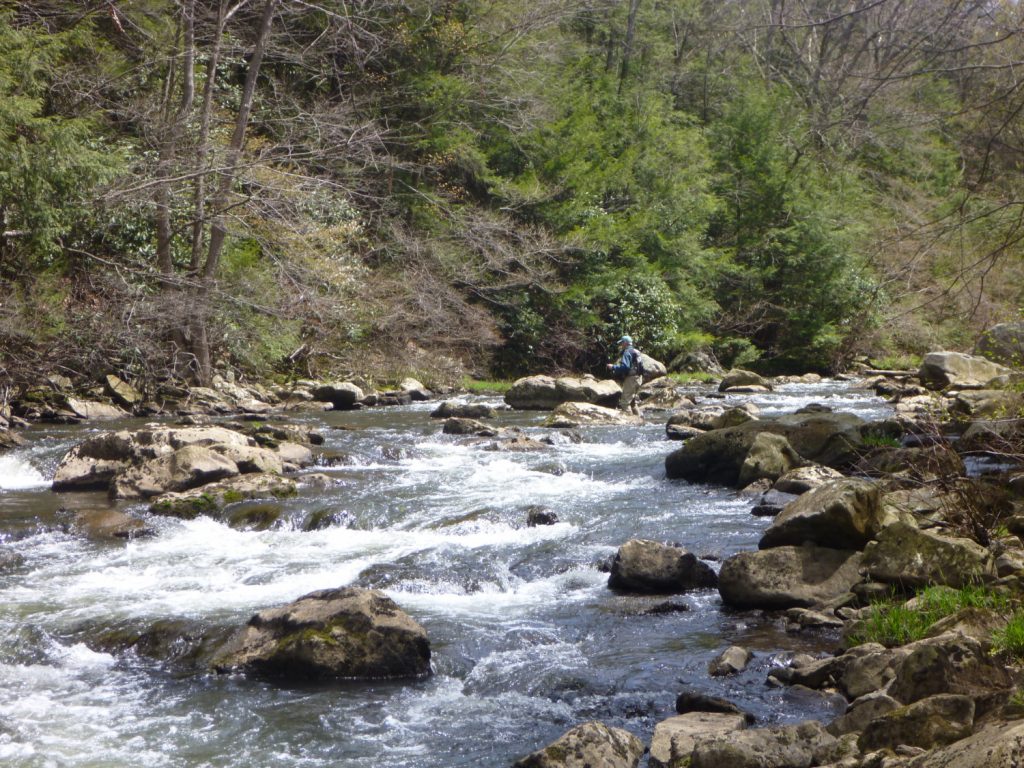
Laurel Highlands Priority Waters – A Special Place
Trout Unlimited National has identified our Laurel Highlands waters as among those most worth restoring, protecting and reconnecting as trout strongholds for the future.
Photo: Low water conditions in Linn Run in the Summer of 2024
Our readers, and especially trout anglers, witnessed how low our streams dropped this past summer and early fall. Some of the smaller streams didn’t have enough water between pools for fish to navigate. That becomes a serious problem when fish are locked in pools where the water continues to drop along with dissolved oxygen and the water temperature rises. Unless trout can navigate downstream to better water conditions, they’ll be stressed, possibly beyond recovery. Stress makes fish more prone to disease and gill lice. And they certainly become easier prey for birds and animals that find them to be a delicacy. One more unfortunate conundrum caused by climate change!
We fishers obviously can’t control climate change, at least not directly. But what we can do is modify our fishing tactics and ethics when droughts impact our favorite streams. If we claim that fly fishing is one of our prime, outdoor activities, then it becomes our responsibility to help preserve the fish that we pursue. In this case, I’m speaking primarily about trout in general, and wild trout in particular. These are coldwater species most impacted by climate change – lower water levels and higher temperatures. Warm water species such as bass, muskies and pike will have a better chance of survival on their own.
Trout thrive in water temperatures between 44 and 64* F. Trout fishers understand the logic behind the PA Fish and Boat Commission’s delayed harvest program. After June 15th each year, the trout stocked earlier in the season can be harvested. In fact, in most of the delayed harvest streams, it is best to do so, so that they don’t die from warm water and low dissolved oxygen during the hot summer months. Some stocked trout may still survive if they can find acceptable water. But for wild trout, their challenge can be even more pronounced.
In the Laurel Highlands, we have numerous small mountain streams where brook, rainbow and brown trout reproduce naturally. The rainbows spawn in the spring while streams are flowing well and before drought takes its toll. But brooks and browns spawn in the fall and both travel to the headwaters to reproduce. Low water levels from droughts make spawning a challenge. Some trout may not be able to reach their previous nursery waters because there’s simply not enough water to navigate.
If you’ve hiked along headwaters in the fall, you may have seen wild trout creating spawning nests, called redds. The female will hollow out a bowl in shallow, gravel bottoms of the stream, then line it with tiny pebbles in which she’ll lay her eggs. The male will swim over the eggs and fertilize them. You may have seen the videos on PBS or other nature programs.
The brook trout (actually a char) is Pennsylvania’s state fish. That’s reason enough to want to protect it. Some anglers refer to themselves as “blue-liners”, because they fish almost exclusively the small streams (blue lines) on topo maps. They find wild trout to be most challenging and rewarding. And they are by far the most spectacular in color, especially during mating season. For the most part, blue-liners handle their catches gently and release them.
We need to be especially careful during the spawning season. Its not ethical to fish near redds. Knowing that the adult fish will likely take your lure while trying to protect the nest from predators is hardly sporting. And even wading or crossing a small tributary can damage the redds. We need to be careful where we step so as to not damage the nests or eggs. Trout Unlimited goes to special efforts to conserve, protect and restore our wild trout waters. We promote a catch-and-lease ethic for wild trout. There are plenty of stocked trout to sizzle up in the skillet. We have a truly amazing natural resource in wild trout in Pennsylvania. This resource can be “renewable” if we follow some simple ethos – don’t pressure them during low water conditions or spawning seasons, and don’t damage their redds.
During low flows in the summer, there are larger, local streams such as the Youghiogheny River locally that still fish well. Early morning and dusk usually produce hatches and trout are most active during those times when the sun is not so bright. Many of us who fish don’t restrict our time on the water to just trout. We have other warm water species just as challenging to pursue.
As a segway, let’s talk about how climate change might impact steelhead fishing in the fall in the Lake Erie tributaries. Many of our readers have taken advantage of the fall runs. Those tribs can face similar situations with low water. This past fall, heavy rain in mid-September brought the water levels up enough that steelies made a run up many of the tribs from the lake. But as dry days turned into weeks without rain, water levels dropped and fish were trapped in pools. No one likes to fish in streams over-flowing their banks. We prefer the water levels to be down a little which allows us to read the stream and focus on prime holding and feeding areas. But when the water gets really low, we have to ask ourselves if chasing steelies in a confined pool is really sporting. Chances of fowl hooking a fish skyrockets. And even if we do catch fish in a sporting way, we’re still stressing them beyond acceptable levels if they can’t escape the small pool they’re locked in.
Personally, I find no pleasure fishing even within fifty feet of someone else unless they are family or friends. That’s not always possible when fishing stocked streams in Pennsylvania on opening day or fishing for fresh-run steelies. But I also want to believe that most anglers would rather have a hook-up by fooling a steelhead into taking their lure because it thought it was real food, not accidently while it’s trying to escape the scene. You identify a good looking feeding station, you make a good cast, get the perfect drift, then bam, fish on! Some anglers intend to keep and eat their steelhead. That’s their choice. But if you’re practicing catch and release, try to land the fish as quickly as possible. If your intent is to release it for someone else to enjoy, then try not to stress it by playing it until it goes belly-up. You’re defeating your purpose.
I’ve had some of my best days fishing for steelies on cold and ugly winter days. The Lake Erie tribs levels will rise when the recent three feet of snow melts by mid-December. You can expect more fish to come in at that point. We don’t need to hammer the steelies in drought conditions. Better stream conditions will eventually follow. Check the live creek cams at www.unclejohnselkcreekcamp.com for current conditions.
There are many ways to enjoy fishing in Pennsylvania. We have 6,000 miles of streams and waterways. Of those, 300 miles are of high quality and exceptional value streams and 100 miles of Class-A wild trout streams. Most of these can be fished year-round except prior to stocking in the spring. If you find the stream conditions are such that fishing pressure is going to stress the trout, please consider an alternative.
Photo: The Stonycreek River in Somerset County
Our readers may recall that in 2023 Forbes Trail Trout Unlimited (TU) completed a Coldwater Conservation Plan (CCP) for Linn Run. The purpose of the study was to determine the overall health of the stream and identify any issues that might require attention. The was lead by TU but in partnership with many state and local agencies and natural resource conservation organizations. The final report identified a number of issues that need to be addressed, including problems in the headwaters where wild brook trout spawn.
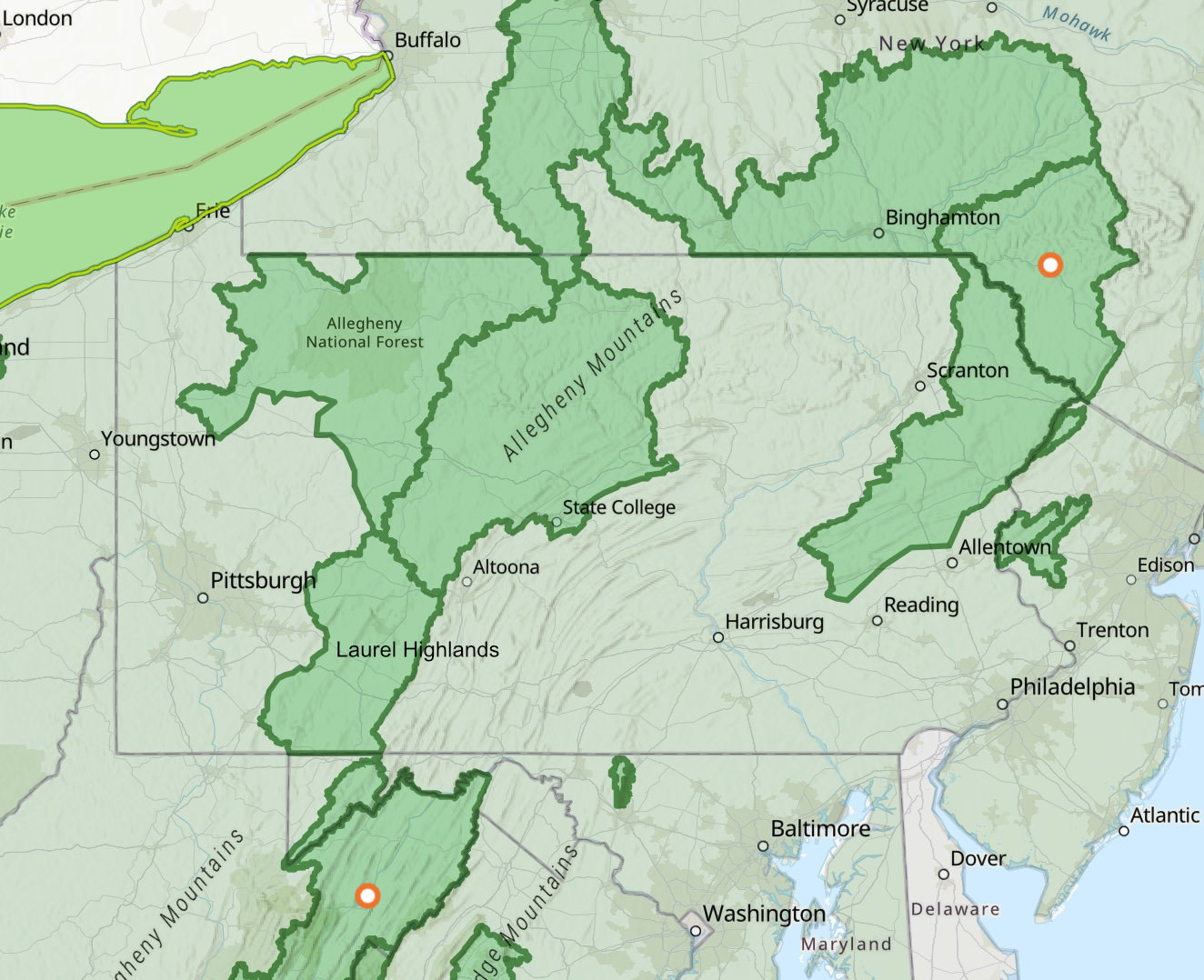
Linn Run, a tributary of Loyalhanna Creek, is a high-gradient mountain stream classified by the PA Department of Environmental Protection (PADEP) as a High-Quality, Coldwater Fishery. It is also classified by the PA Fish and Boat Commission (PFBC) as a Wild Trout Fishery. The stream spans nearly seven miles from its headwaters in Forbes State Forest, through Linn Run State Park, to where it enters the Loyalhanna Creek below Rector. It is probably safe to say most, if not all of our readers, have visited the stream and Linn Run State Park many times.
Linn Run, and several of its tributaries, support a modest population of wild brook trout, and a relatively healthy population and diversity of macroinvertebrates…trout bugs. The lower section of the main stream is stocked with rainbow trout in the spring which attracts lots of anglers. The stocked trout are intended to be caught and consumed by anglers. But TU strongly encourages anglers who catch wild trout to handle them gently and release them safely, even if they are of legal size. Wild brook, rainbow and brown trout are part of a fragile ecosystem in the Laurel Highlands and their population can turn very quickly. Brook trout spawn in the fall in the headwaters of Linn Run and several of its tributaries. This natural reproduction makes Linn Run a very “special place” for TU and many local outdoor enthusiasts.
Forbes Trail is one of forty-nine TU chapters in PA. TU is a national, nonprofit organization made up of state councils and chapters. Our mission is to conserve, protect and restore coldwater fisheries and their watersheds. Just a couple of years ago, the national organization started a program to identify our most critical trout and salmon waters across the country. Once identified, TU will work with federal, state and local agencies and like-minded organizations to preserve them. The effort is called TU Priority Waters Initiative.
In January of 2022, PA TU Council, with input from local chapters, began considering which streams and watersheds across the Commonwealth to include in the Priority Waters program. After weeks of deliberation, four watersheds were identified: Allegheny, Delaware, West Branch Susquehanna and the Laurel Highlands. The Laurel Highlands contain an estimated 6,000 miles of coldwater streams, with 300 of those stream miles designated as Exceptional Value streams (Class A Wild Trout), including 30 miles of Wilderness Trout Streams (Natural Reproduction) by the PADEP in 2019.
Because of the elevation, the weather of the Laurel Highlands is generally cooler and wetter than in most parts of the state. In 2021, Cindy Adams Dunn, Secretary of the PA Department of Natural Resources predicted the Laurel Highlands to be the last remaining climate refuge of the Commonwealth’s wild, self-reproducing trout.
Once the Laurel Highlands was approved at the national level of TU as Priority Waters, a group got together in early 2025 to draft a strategic action plan to better protect those natural resources. Representatives from TU chapters covering the Laurel Highlands and the Westmoreland Conservation District sat down to draft a five-year vision statement, conservation goals and primary conservation strategies. The effort was led by Scott Koser, Program Manager for Trout Unlimited Coldwater Habitat Program in PA and the state lead for Priority Waters. The group is in the early stages of identifying specific actions to take on trout streams in the Laurel Highlands. But work has already begun on Linn Run.
Mentioned earlier in this article was the problem with wild brook trout reproduction in the headwaters of Linn Run. After decades of impacts from acid rain, the soils and bedrock on Laurel Ridge where Linn Run originates has lost its buffering capacity. The problem starts with a low pH in the very top of the stream. But the real culprit is dissolved aluminum that leaches out of the soil because of the acidic groundwater. Aluminum is toxic to fish, especially newly hatched brook trout. During electrofishing surveys, adult trout have repeatedly been found in the headwaters, but no young-of-year.
As a means to remediate the problem, TU began liming the headwaters this past spring in an effort to boost the pH and precipitate out the aluminum. Quarterly water quality testing will ascertain if the treatment is improving pH and aluminum. Follow-up electrofishing surveys will provide the ultimate answer. Will the improved water quality allow the young-of-year wild brook trout to remain where they were born? This fall, TU will work with local citizen scientists to survey the headwaters and major tributaries for fish beds called “redds”. Wild brook trout move to the headwaters in the fall to pair up and spawn. The female scoops out a small depression in the stream bed then lines it with tiny pebbles in which she’ll lay her eggs. These redds can be observed and counted while walking along the stream. Using this fall as a baseline, and with continued electrofishing, we’ll be able to determine if our efforts are improving the nursery waters.
Other problems identified in the CCP were the presence of gill lice in some of the trout, likely introduced by hatchery trout. Research by Duquesne University will begin this summer to develop an in situ testing process to determine if gill lice are present just by analyzing the stream water. Hemlock Woolley Adelgid is another threat to the watershed. Fortunately, DCNR has been systemically treating trees for several years to control the invasion. Large stands of mature hemlocks line the stream from the State Park Office downstream providing cover to keep the water cool. Hemlocks only provide a small portion of the tree canopy in the headwaters. There, the spongy moth continues to defoliate the hardwood canopy. But the damage is not considered severe.
A bigger problem is deterioration to Fish Run Trail from periodic flooding causing a safety issue for hikers and mountain bikers. Being a high-gradient stream, flash floods can cause serious damage to Linn Run. With climate change, storms can be expected to become more frequent and fiercer. A grant has been applied for to remediate the trail safety issues. Thousands of hikers, fishers, hunters, birders and mountain bikers flock to Linn Run each year to enjoy the natural beauties. TU and its partners including DCNR are working to make the watershed safer and to enhance its ecosystem.
It’s important to preserve this watershed not just for the wild brook trout, but so our readers can continue to enjoy its beauty as well. The stream and trails provide the public an opportunity to cool off in the summer; a prime example of climate change resiliency. We consider Linn Run to be one of the “crown jewels” of Westmoreland County. Fortunately, the Laurel Highlands is blessed with many such watersheds that warrant further protection. TU’s Priority Waters initiative will help provide the attention and resources needed to protect these special places.

A Brief History of Forbes Trail TU
In response to the devastating effects of Hurricane Agnes on Loyalhanna Creek in the Ligonier area, the Forbes Trail Chapter of Trout Unlimited was formed in 1973.
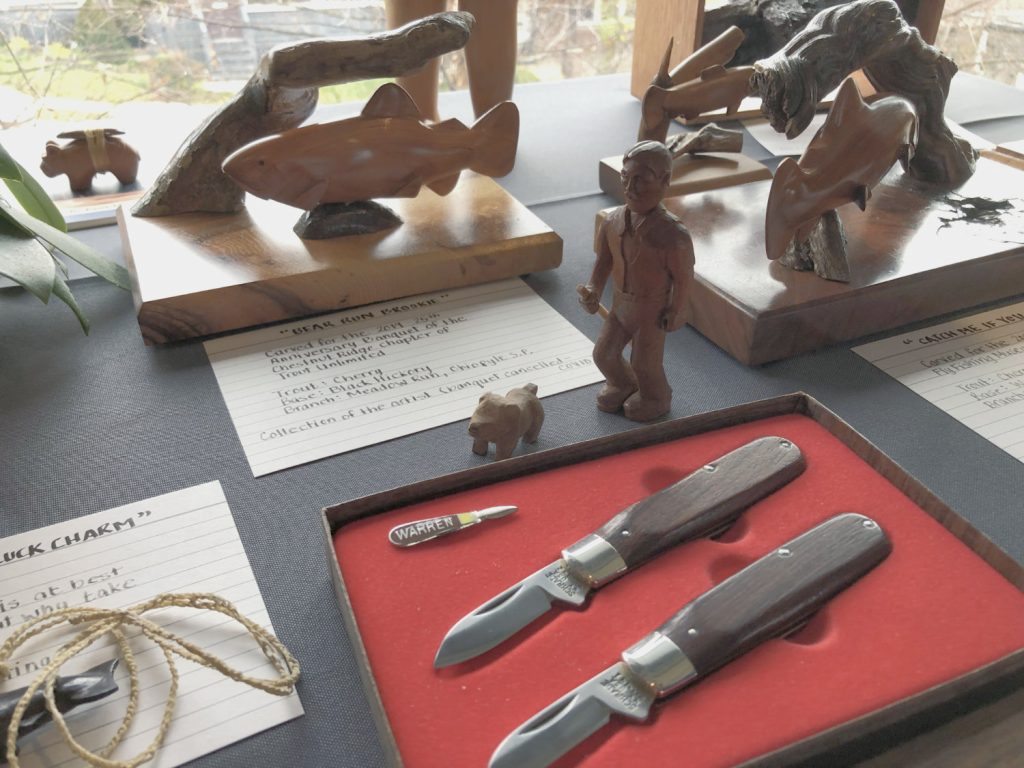
The Whittler
Rod Cross, a director for Forbes Trail Chapter of Trout Unlimited, was invited to display his art work and explain his hobby at the Westmoreland Museum of American Art in Greensburg.
Photo: Forbes Trail Trout Unlimited receives the National Golden Trout Award, TU’s highest award, in 1977. National Director Inky Moore is the presenter. Chapter President Frank Felbaum of Ligonier, and Past President Tom Patten of Latrobe are accepting the award.
The headwaters streams of the Loyalhanna Creek are the chapter’s home waters. They flow down from Pennsylvania’s Laurel Ridge, one of America’s most historic, and environmentally significant landscapes. This rugged terrain preserves one of the world’s most biologically diverse forests. These high-gradient streams are home to wild populations of Eastern Brook Trout, Pennsylvania’s native trout.
Delaware Indians migrated here from the Susquehanna River Valley in the early seventeen-hundreds. They settled beside the mountain stream they called Loyalhanning, or “middle stream”. Their village, now the village of Ligonier Pennsylvania, was on the Raystown Path, an Indian trail leading from the English colonies in the east, to the French colonies west of the Allegheny Mountains.
The inevitable clash between British and French fur traders, and their Indian allies led to the French and Indian War. In 1758 British General John Forbes led a military expedition against the French Fort Duquesne at the forks of the Ohio, modern day Pittsburgh. He blazed a rough military road from Carlilse across the Allegheny Mountains that became known as the Forbes Trail. Thus, our chapter’s name.
Forbes’ second-in-command, Colonel Henry Bouquet, supervised construction of a strong fortress along the middle Loyalhanna Creek. He named it Fort Ligonier in honor of the British Commander in Chief, Lord Ligonier. Bouquet was a member of Philadelphia’s Regale Fishing Company, and from Fort Ligonier he sent back east for his fly rod. We credit him for introducing fly fishing to the Loyalhanna Creek.
When these Europeans crossed Pennsylvania in 1758, trees covered nearly all of it, and brook trout swam in all its streams. Within a hundred years Pennsylvanians had cut down two-thirds of their trees, and brook trout were gone from ninety percent of their streams. During the conservation movement that followed, heroes like Joseph Rothrock, Pennsylvania’s “Father of Forestry”, and the “Tree Army” of the Civilian Conservation Corps largely reforested our Commonwealth.
The trees returned, but not the trout. From a fisherman’s perspective headwaters streams like Linn Run stopped being trout streams in 1959. Many of the trout stocked by the state into these streams died. The state seriously considered taking them off the stocking list. The culprit was the newly identified acid rain.
Coincidently, a group of trout anglers who fished Michigan’s Au Sable River became concerned about the declining quality of their trout fishing. In 1959 they organized to do something about that. They called their organization Trout Unlimited. The big idea was, if we take care of our trout streams, our trout fishing will take care of itself.
Mother Nature, in an unexpected way, gave Ligonier trout anglers a reason to organize their own TU chapter. On June 21st, 1972 Hurricane Agnes flooded Western Pennsylvania with nearly 15 inches of rain in a 24-hour period. It devastated trout fishing in the Loyalhanna watershed. Local anglers Don Robb, Tommy Evans, Frank Felbaum called a meeting of like-minded anglers at Sleepy Hollow Tavern on the banks of the Loyalhanna Creek in April 1973. Ken Sink of Indiana, PA, in his role as TU State Council President, presided over the organizational meeting, and presented Forbes Trail Chapter 206 its charter.
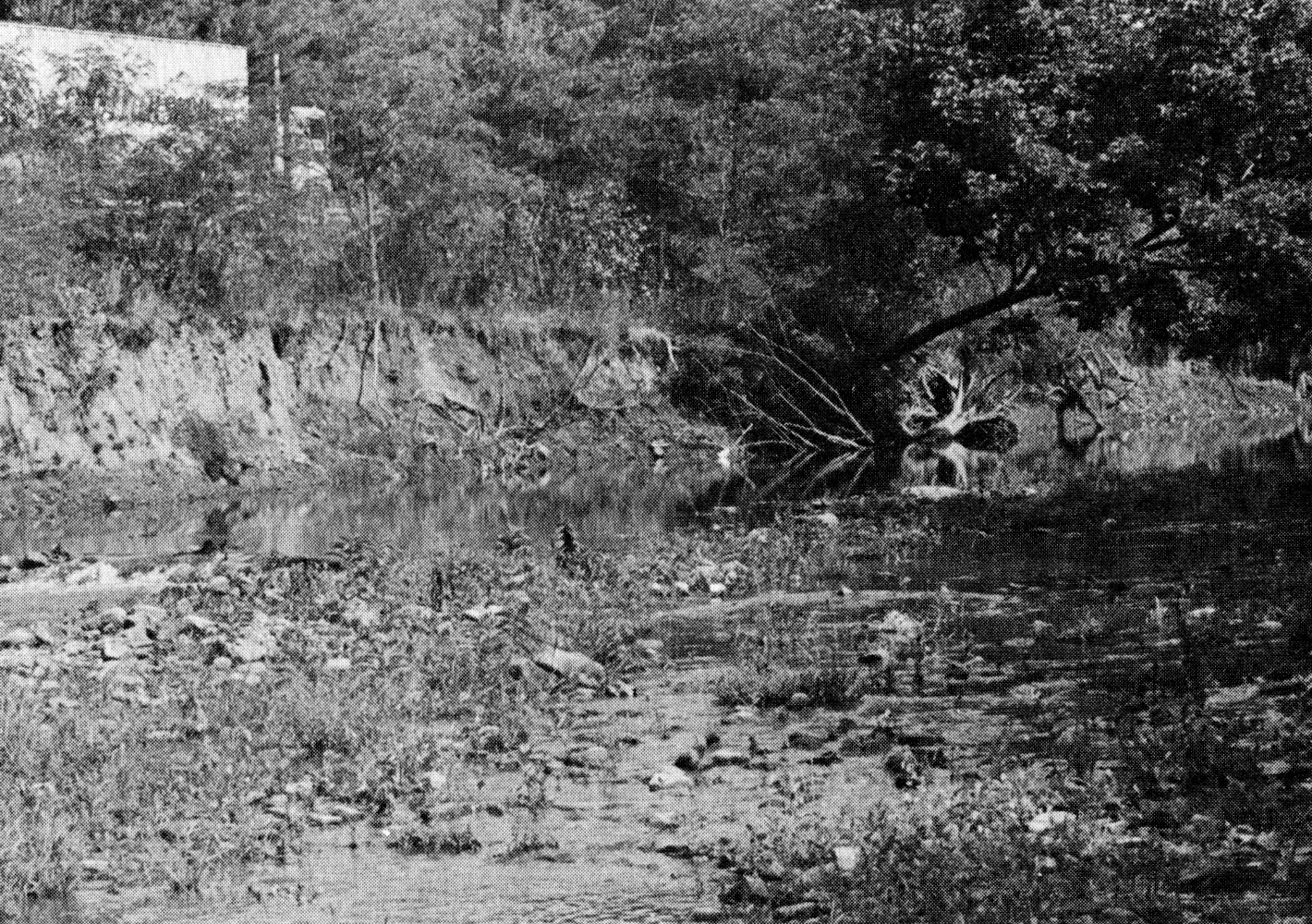
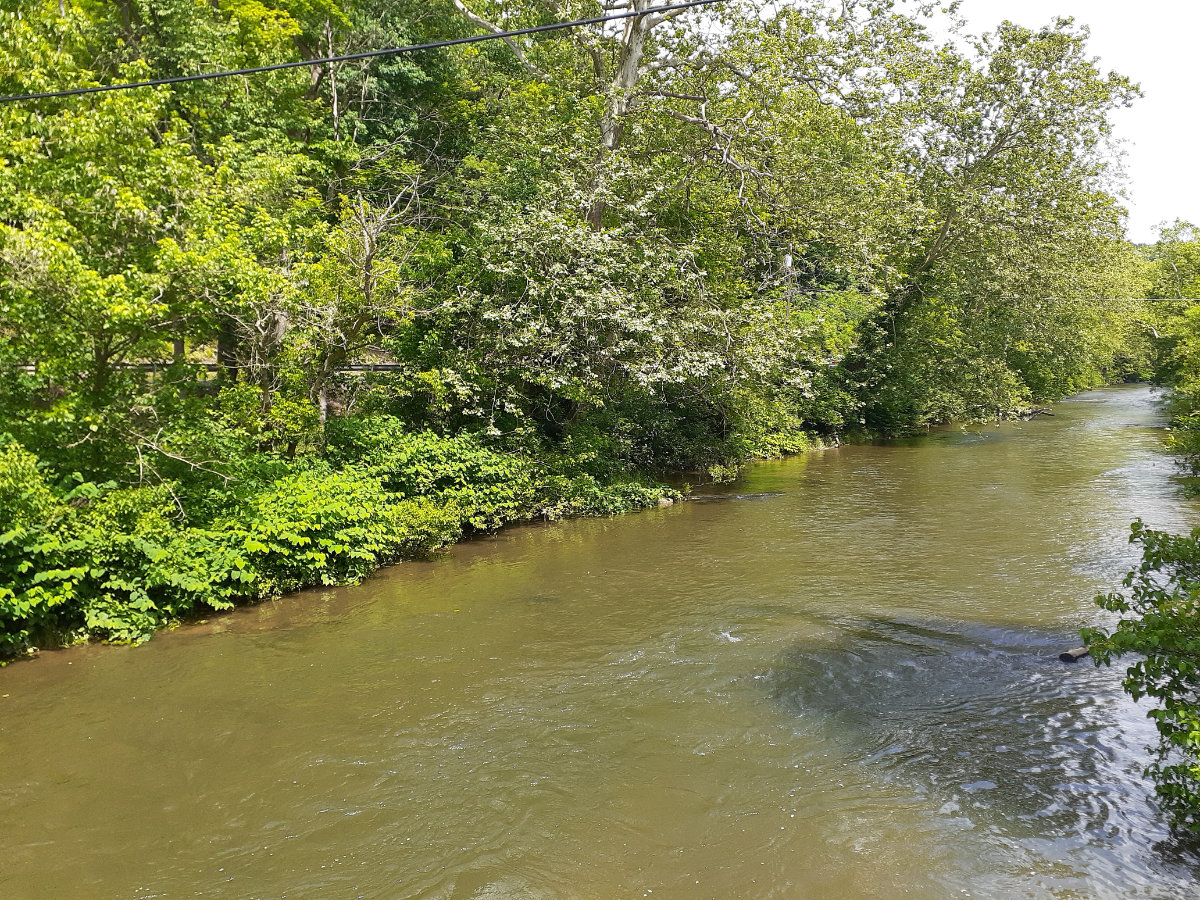
Forbes Trail chapter quickly achieved a major success restoring the Loyalhanna Creek as a trout fishery. The chapter received the prestigious national Golden Trout award in 1977 for that conservation achievement (See photo). The stream section between the Route 711 Bridge and the Two Mile Run Bridge in Ligonier has become the popular catch-and-release area designated a Keystone Select Trout Fishery by the PA Fish & Boat Commission. It has a positive impact on recreation and tourism, and therefore on our local economy.
Then the chapter took on the challenge of restoring trout habitat in Mill Creek, Ligonier Township. Volunteers conducted outdoor scientific studies published a definitive conservation plan. Then, they accomplished the indoor work of public hearings to securing the grassroots and landowner support for grant funding. The decade-long habitat restoration project included more than 100 stream structures along 5 miles of trout streams, and more importantly justified upgrades of stream classifications that afford additional protections from development and non-point source pollution.
By the new millennium the chapter had assembled a highly capable corps of volunteers and was able to begin restoring Linn Run back into its original banks in Linn Run State Park, and remediating acid rain and gas well drainage that had destroyed the trout habitat. This project required significant fund raising and years of hard physical labor. By spreading hundreds of tons of limestone sand along the headwaters, acidity was reduced and Pennsylvania’s state fish, brook trout, were reintroduced. Forbes Trail Chapter received Pennsylvania Council’s Chapter of the Year Award for that achievement.
Today our volunteers monitor trout streams to detect potential impacts from Marcellus Shale gas extraction, and winter road salt. They assist Penn State Master Naturalist programs. They partner with Girl Scouts earning Stream Girls Badges, and Boy Scouts earning Fly Fishing Merit Badges. We work with landowners to maintain a “Kids Only” handicapped accessible trout fishing area on Four Mile Run.
We continue to focus on the future by introducing the increasingly indoor, Internet generation of young people to trout fishing and coldwater conservation. Our Outdoor Club Youth Group gives boys and girls the opportunity to develop fly fishing skills and become conservation minded. Our Trout in the Classroom programs helps students learn science and math by raising trout from eggs and releasing them into the wild. It’s a fun and highly motivational program that starts them applying school work to real world problems and thinking about their environment. Forbes Trail’s youth programs have repeatedly been named Pennsylvania TU’s best.
Rod is multi-talented and puts many of his skills to work during TU events, including being the chapter’s go-to instructor for fly casting. But his passion is really in “whittling” which he proudly distinguishes from “carving” where the wood is held in a vice. Whittling involves holding the raw wood in his hand and using a small knife to produce the intricately designed final product.
Like many artists, Rod prefers the quiet of his wood shop to create his masterpieces with just music playing softly in the background. Many of his pieces take a full week of work, including as many as 20 coats of tung oil. The oil gives the wood a rich, glass like finish, penetrating the wood to help preserve it. Rod’s wife Judy was on hand to greet visitors and to share the stories behind the artwork.
Forbes Trail is blessed with so many talented members willing to give of their time and talents to help promote our mission of conserving our coldwater fisheries. But what’s more interesting sometimes is their backgrounds, and what to do in their spare time.
Many of Rod’s art pieces tell a story, including the source, and importance of the wood from which it is whittled. Following is Rod’s introduction to his story for visitors at the museum.
“My name is Rod Cross, and I am a self-taught wood carver, or more accurately, a “whittler”. I was taught to respect and use a knife as a tool, and later as an instrument to create my expression of Art.
My carvings reflect a passion in other areas of my life that bring me joy and satisfaction, as art should.
Trout fishing and conservation have led me to carve the flowing lines of the brook trout, and the carvings are donated to conservation fund-raising banquets.
Over the years the carvings that give me the most satisfaction are the simple cherry nativity scenes that I carve for one person, or a family each year. This gift of giving has given back to me the real meaning of the Christmas season.
And trout pins for hats or vests are carved and given to fishing friends, and a former President and First Lady.”
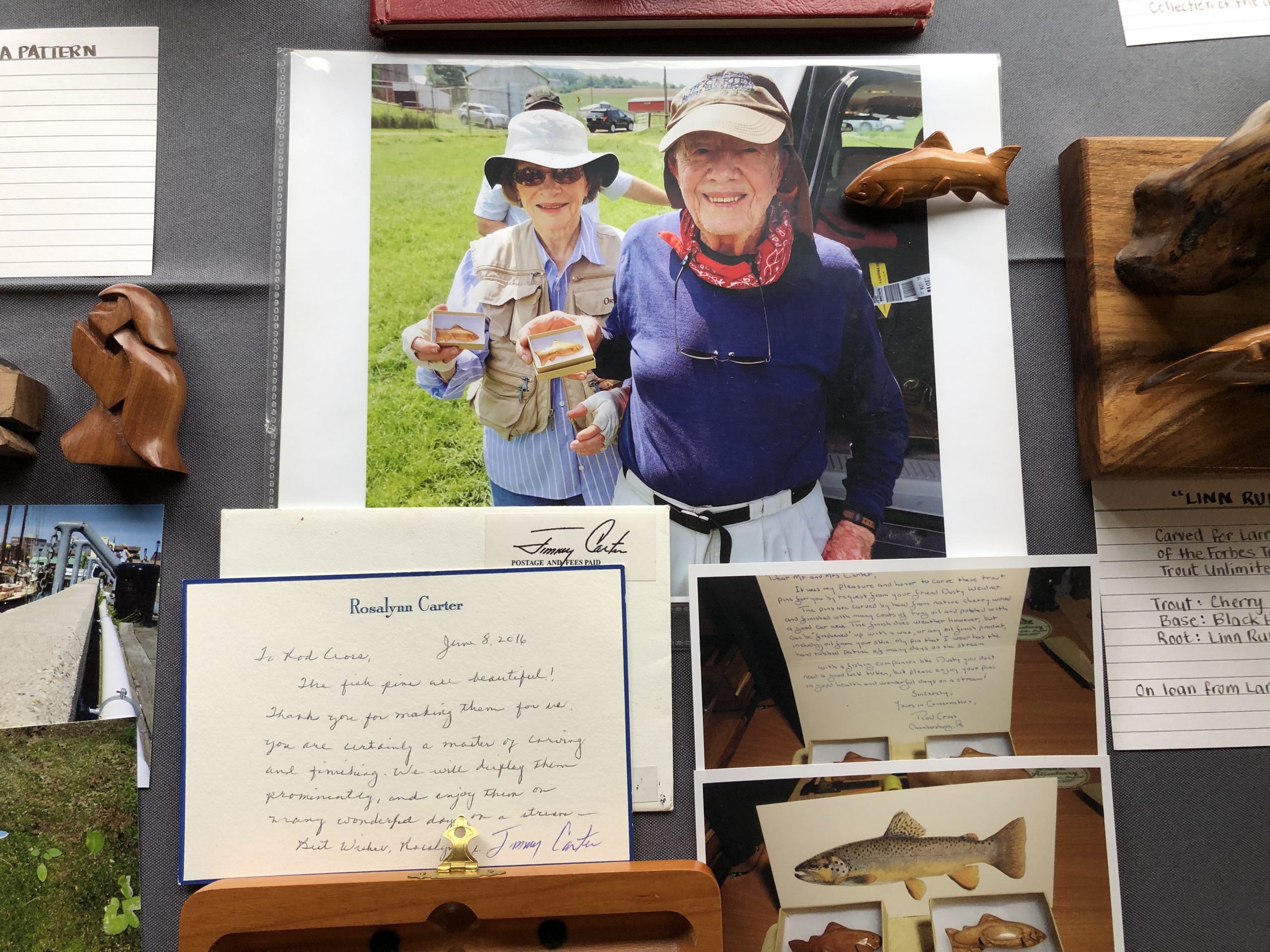
Cross grew up in North Huntingdon Township. His working career was in the industrial gas business, first driving a truck, then retiring as a Regional Operations Manager for the Northeast.
Many long hours away from home and in hotels gave him time to find relaxation as he carved the various projects that he worked on, including nativity scenes for his grandchildren.
Although retired, Cross is proud to work for the Western Pennsylvania Conservancy as an Educator/ Guide at Frank Lloyd Wright’s “Fallingwater” along Bear Run. There he is immersed in art, nature and the opportunity to continue being a life-long learner.

Pennsylvania Fly Fishing History
Pennsylvania and Pennsylvanians have played a major role in the history of fly fishing and fly tying.
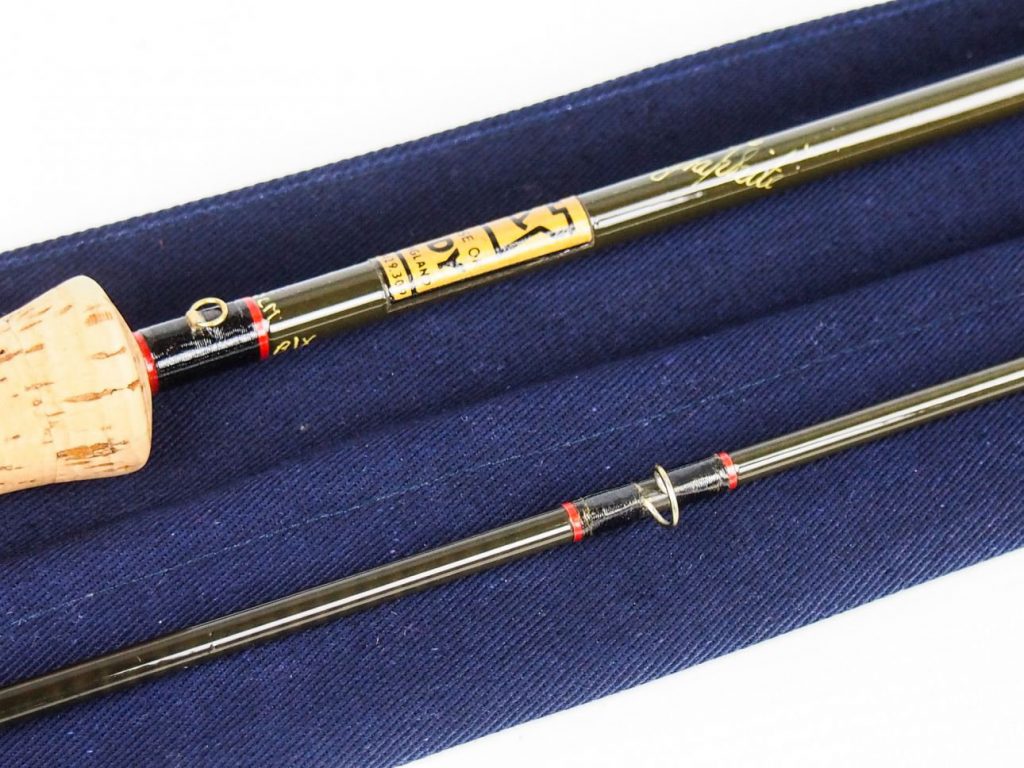
50 Years of Graphite Fly Rods
Graphite fishing rods make up the vast majority of rods manufactured today, however 50 years ago, our chapter’s founders were more familiar with fiberglass and bamboo.
Photo: The Letort Hopper a fly pattern developed by Ed Shenk of Carlisle, PA
Fly fishing in America has a rich and glorious history and many associate its development to the era of the “Catskill school” of fly fishing in New York. This is certainly true to a point. Expanded train travel made the streams of the Catskills, the Beaverkill, Neversink and Esopus more available to the anglers in New York City and significant traditions were established in fly tying and insect study.
Whether New York is the cradle of American fly fishing is very much debatable though. Pennsylvania anglers have made and are still making important contributions to the science and art of fly fishing.
Let’s look at some of these contributions. First, there has been and hopefully will always be the fly fisher who prefers the classic look and feel of the hand crafted six-sided split bamboo fly rod. In the 18th century rods were crafted from various woods, lancewood, greenheart, and blackthorn and were good for reaching out to “dap’ a fly or swing a brace of wet flies downstream.
By the middle of the 19th century anglers wanted a rod better suited to casting the silk lines being developed to cast and present an imitation fly upstream to rising trout. In the 1860s a gunsmith and violin maker from Easton, Penna. named Samuel Phillippe built the first hexagonal split bamboo fly rod. This tradition of close tolerances and fine craftsmanship is being carried out today by skilled production facilities like R. L. Winston in Montana and by curious and talented amateur rod builders in basements and garages in Anytown, USA. One of his rods is archived in the Pennsylvania State Museum in Harrisburg.
The members of the Forbes Trail Chapter of Trout Unlimited work with Mr. Ryan Podlucky’s Outdoor Club at the Ligonier Valley Middle School through the winter by teaching fly tying and fly casting. Fly patterns chosen for the classes reflect our Pennsylvania contributions.
Examples are the “Walt’s Worm” developed by Walt Young of State College in 1984. The pattern is simple and effective and perfect for new fly tiers. Another easy fly for the beginner, but an important imitation of an inchworm is the “green Weenie” fly. This very effective imitation was first made by Ken Igo and Russ Mowry of Westmoreland County but popularized by Penna. outdoor writer Charlie Meck.
Readers, I ask you, who does not have a “Black Woolly Bugger” in their fly box? This staple of any fly-tying class everywhere was invented by Russell Blessing of Harrisburg, Pa. Russ made the first fly in 1967 to fish for smallmouth bass, but the fly has taken fish species from carp to tarpon. Some say that the fly is the most important fly pattern ever invented and is fished by fly anglers around the world. This fly was named by Russ’ seven-year-old daughter Julie who told her dad the fly “looked like a woolly bugger”.
Al Troth was born in Monessen, Pa. and taught Industrial Arts in Williamsport. He developed the “Elk Hair Caddis” fly to fish as a wet fly on Pennsylvania waters, but the darn thing kept floating with its elk hair wing. It became “the” dry fly imitation of the prolific caddis fly, but don’t forget to sink one on the downstream retrieve and be prepared for a savage strike, as the outdoor writers say. Al Troth’s pattern can be found in fly boxes and catalogues East and West.
From the limestone spring creek axis of Carlisle, Chambersburg and Newville came the revolutionary approach to summer trout fishing, the terrestrials. Vince Marinaro, a lawyer, from Mechanicsburg observed wild trout taking land born insects falling or being blown onto the stream. He tied his Jassids, beetle and hopper patterns that are standards in Penna. fly selections.

Ed Shenk tied his famous “White Shenk’s Minnow” and the “Letort Cricket” to fish to those notoriously selective of his beloved Letort Spring Run flowing through his hometown of Carlisle.
Before the Civil War years Elizabeth Stairing Benjamin tied flies for the anglers who fished for brook trout in Lycoming Creek and became the first woman commercial fly tier in America. Her “Queen of the Waters” became the fly of choice for big city anglers that came to catch the “speckled trout” that were native to her part of Pennsylvania.
In the arena of teaching and promoting the sport of fly fishing we must recognize George Harvey of State College who in 1934 sat and taught the Dean of Penn State to tie flies, and how to use them. From that time until his retirement in 1972 Mr. Harvey taught 35,000 students in the first accredited angling class in the country. The program is still being offered today, and there is a waiting list to get into it.
For the angler and hunter came some help from a fellow Pennsylvanian who observed fish feeding in a lake on his property and linked the activity to the cycles of the sun and moon. John Alden Knight of Montoursville created the “Solar Lunar Tables” that used to be published every day in newspapers. The tables predicted high and low activity periods of the day, however most of us feel that the best time to go fishing or out in the field is “whenever you can”.
This is a small sampling of what Pennsylvanians have contributed to the art and science of fly fishing. Some of the folks mentioned are no longer with us, but their influence continues to this day. Fortunately, this tradition continues today with talents like George Daniel of State College, Mike Heck of Chambersburg, the men and women of the Fly Fisher’s Clubs of Harrisburg and Pittsburgh and friends and neighbors who belong to cold water conservation groups like the chapters of Trout Unlimited and of dedicated volunteers and professionals in the Western Pennsylvania Conservancy and the Loyalhanna and Mountain Watershed Associations.
In 1998 the Pennsylvania Fly Fishing Museum was established to recognize and protect our heritage of the sport. The museum, your museum, is located at 101 Shady Lane in Carlisle, Pa. and is open free to the public. Beautiful display cases line the walls and aisles of the museum and are packed with flies, books, equipment, and other historic and groundbreaking developments related to the contributions of the women and men who loved fishing the waters of Penn’s Woods.
You can visit the physical museum or go to the website www.paflyfishing.org to explore or to donate and join the 501c3 association. Remember also that when you help a young person in a classroom or on the stream or teach a wounded veteran or breast cancer survivor how to heal with the therapy of fly fishing you are just as important to them as any of the museum featured “Keystone State” anglers that came before us. Keep up the good work.
Photo: An early graphite rod made by Hardy in Alnwick England
In a previous article about the history and contributions of Pennsylvania toward the sport of fly fishing in America it was written that Samual Phillippe developed the split bamboo fly rod in the 1860s. This beautiful craft is still being practiced today.
Fiberglass was developed by the airplane industry during WWII and many thought that the bamboo fly rod would finally be replaced with the new material. That did not happen, but the fiberglass rod was an important step forward for the fly fisher. A fiberglass rod was much less expensive than bamboo and required no special care or treatment like the cane rod.
“Glass” rods still have a dedicated following. Like bamboo rods they have a slower action and the cast can be felt as the line “loads” the rod for the cast. Early rods were not very good casting tools, but as the material developed and was put in the hands of rodmakers like Russ Peak, and J. Kennedy Fisher the rods began to be compared to the “casting action” of a good cane rod. Now makers like Mike McFarland, Redington, Echo and Scott are making quality glass fly rods. However, they are no longer cheap!
This material development lasted for 20 years, but in 1973 a new material, graphite, was introduced to the fly-fishing community. This is not pencil lead graphite but rather a carbon fiber that is arranged longitudinally in a resin or epoxy that can be rolled into a shape, any shape. A fly rod or a golf club for example. This material was developed in the U.K. for the Royal Air Force. Remember, in the aviation and now the aerospace industry world “lighter and stronger” is the Holy Grail.
Rods were developed by Hardy in the U.K. and by Fenwick here in the US. Both companies claim to be the first. Still debated today. Graphite rods were introduced to America in 1973 by Fenwick at an American Fishing Tackle Manufacturing Association (AFTMA) show and by early 1974 they were made available to the public.
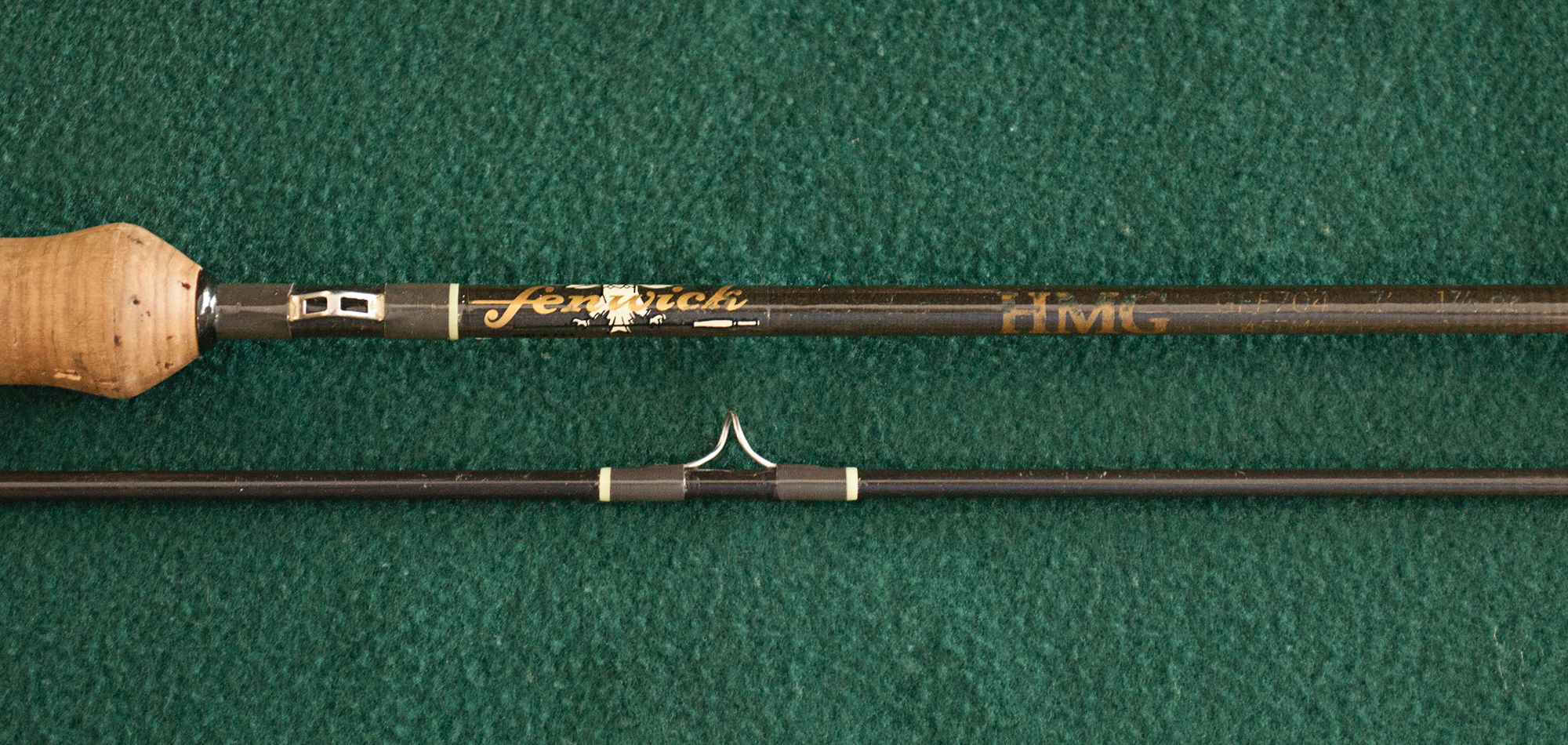
Graphite is now 50 years old, and we should recognize this important recreational material development. The tight weave and high modulus strength of the material has allowed manufacturers to design fly rod tapers to accommodate rods to meet all of the styles and uses of fly rods from “blue line” brook trout streams to rods that equalize the battle between a tarpon or sailfish and the angler lucky, or brave, enough to hook one of these lords of the sea.
At first the stiffness and lightness of graphite promised the average angler the ability to throw an entire fly line, 90 feet, with grace and ease. In reality a few casting lessons could make this possible, not the material.
It has been said that the early rods had a tendency to fracture and “explode” under certain conditions and stresses. It is not certain how many of these explosions were fact, fishers have been accused of exaggeration after all. The material did in fact need more development to tame the incredible potential of carbon fiber.
Now a graphite fly rod taper can be built to be a soft progressive parabolic action for dry fly work for example. Or a stiffer taper that gives power for heaving heavy flies like bass bugs, saltwater flies or even big outsized musky patterns. Long rods, 10 feet or longer, whose weight would have been prohibitive in bamboo are easily managed with graphite light weight and small diameters. Long rods with sensitive tips are now designed for the “euro nymphing” enthusiast who is not actually casting the weight of a fly line, but who wants to stay in contact with the subtle takes of trout to the sinking nymph patterns.
Graphite was also instrumental in the development of multi section travel rods and the spigot or sleeved ferrules are practically unfelt in the casting actions of the now popular 5-piece rods that are suitable for all applications, not only for carrying on a plane or strapped to a backpack.
Bamboo rods are revered from makers like Glenn Bracket of Winston, Tom Maxwell and Tom Dorsey of Thomas and Thomas Rod Co. “Midge” rods from Paul Young of Detroit set the tone for the light tackle trend championed by Arnold Gingrich of Esquire Magazine. A fine cane rod will always be respected for its craftsmanship and valued by the angler who can appreciate its place in history.
Is it time to recognize graphite rod materials and tapers that defined an era or a trend in our fly-fishing history? At a recent Forbes Trail Trout Unlimited Chapter outing on Kettle Creek some of the evening “porch cracker barrel” discussions were about what graphite rods members have used over the years. What rod designs floated to the top as rods that did a job well, were fine casting tools, had “lifting” power for big fish, presented flies where you wanted them and with delicacy and grace. For some, the rods needed to be beautifully finished with understated wraps, flawless finish coatings and high-quality ferrules and reel seat wood and hardware.
These observations are highly subjective, like the individual casting styles, fishing techniques and even the aesthetics of fly fishers with a lot of experience. And here lies the strength of this material. It can be made into the ultimate fishing/casting tool for every angler from 1974 until today.
One member offered the opinion that the early “unsanded” rods from Orvis, like the Superfine, the Far and Fine and the Henry’s Fork were their finest rods. Sage of Bainbridge Island in Washington had a rod in 1987 called the LL Series, or Light Line. Try to find one for sale, no one will part with one, especially in a 4 or 5 weight. They were a delight to cast in those light line applications.
The meticulous finish and fine bright work of the Thomas and Thomas Heritage Series in the 1980s and early 1990s understate the smooth progressive actions of the rods with names like “Trouter”, Special Dry Fly” and “Special Extra Dry”.
A truly “legendary” rod first offered in 1989 and still being made today is the “Tom Morgan Favorite” from R L Winston Rod Co. in Twin Bridges, Montana. The late Tom Morgan owned the rod company at one time and the TMF was an 8 foot 4 weight that he designed for delicate presentations on what we call technical spring creek fishing. Tom Morgan said that no matter what year or how old, “a great fly rod is always a great fly rod.”
So maybe it is time to seriously recognize the impact and contribution of the graphite fly rod in the diverse and sometimes highly specialized world that makes up our fly-fishing culture today. There are other materials knocking on our doors, boron for example. Like bamboo and fiberglass though there will always be the individual who will stick with what he or she has found to be the perfect fly rod. A rod that casts to their style, delivers the cast where they imagine it should go, and for some, looks beautiful in the sunlight as they reflect on its craftsmanship. A joy to spend a day on the stream with.
